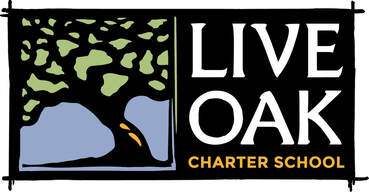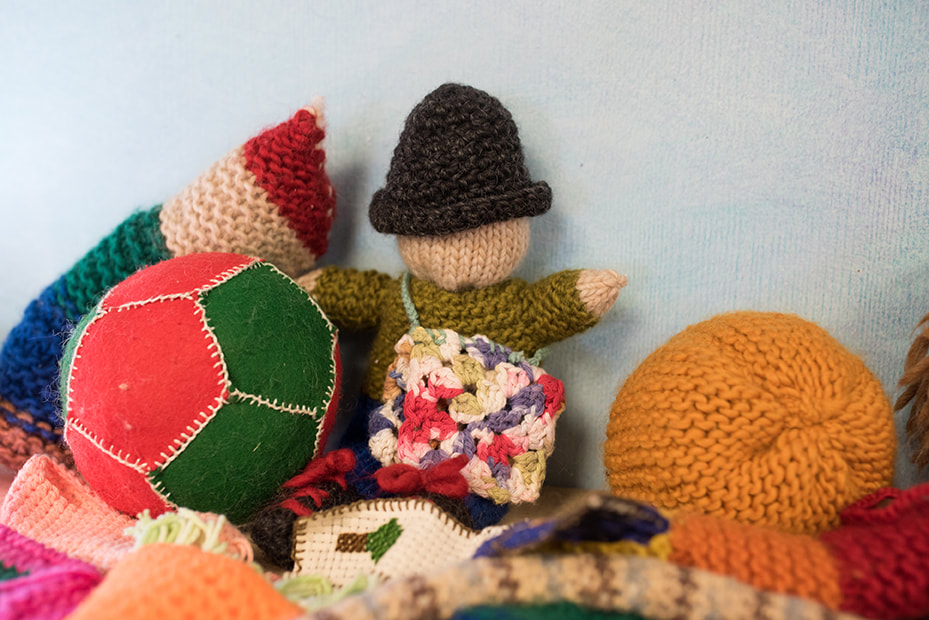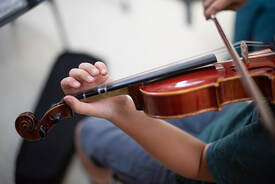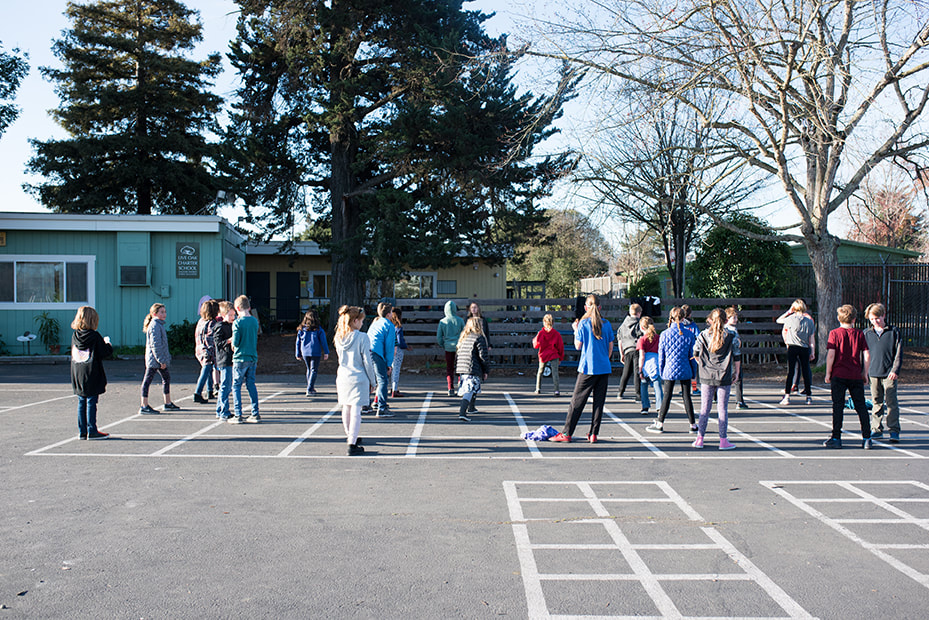Specialty Programs
The Art of Interdisciplinary Education
At Live Oak Charter, Main Lesson work is integrated with projects that occur in the specialty classes of Handwork, Movement/Spatial Dynamics and Performing Arts (taking the place of the specialty Music program in 2023-24) as part of the core curriculum in grades 1-8. Along with the development of manual skills, we see the development of certain human qualities, such as: rhythm, endurance, stamina, and focus. For the older students, it is also a useful introduction to real work.
Multi-skilled Students
In spending time each week in these creative processes, students are provided with a wonderful opportunity to participate in practical activities that build interdisciplinary skills, aesthetic sensibility, and confidence in one’s capacity to create & express from a variety of materials and mediums.
At Live Oak Charter, Main Lesson work is integrated with projects that occur in the specialty classes of Handwork, Movement/Spatial Dynamics and Performing Arts (taking the place of the specialty Music program in 2023-24) as part of the core curriculum in grades 1-8. Along with the development of manual skills, we see the development of certain human qualities, such as: rhythm, endurance, stamina, and focus. For the older students, it is also a useful introduction to real work.
Multi-skilled Students
In spending time each week in these creative processes, students are provided with a wonderful opportunity to participate in practical activities that build interdisciplinary skills, aesthetic sensibility, and confidence in one’s capacity to create & express from a variety of materials and mediums.
Handwork
|
“In the Waldorf curriculum, handwork brings balance between intellectual and movement activities, allowing students to experience the struggle, joy, and care required in the creative process. The rhythmic repetition of knitting and crocheting strengthens a child's concentration and hand-eye coordination. It also enhances math skills through counting rows and stitches, measuring out patterns, and creating three-dimensional items. Children learn to correct their mistakes and value quality, utility, and hard work.”
At Live Oak, each grade engages in handwork to support both what is being taught in the Main Lesson curriculum and the child’s development. The Handwork program is designed to “strengthen the will” while deepening coordination, sequential memory, and spatial awareness. |
Knitting begins in the 1st grade as students learn to use two needles, promoting cross-body movement as well as integrating math through the counting of stitches. As their skills progress, crochet and basic stitchery are introduced. In the intermediate grades cross-stitch and embroidery are taught. By the 6th through 8th grade, students try their hand at three dimensional pattern and object development, doll making, and constructing garments with sewing machines just as they study the Industrial Revolution.
At Live Oak students are not just knitting a hat, they are also practicing math, aesthetic choices, patience and perseverance - how's that for a THINKING CAP
At Live Oak students are not just knitting a hat, they are also practicing math, aesthetic choices, patience and perseverance - how's that for a THINKING CAP
Music
|
Music education plays a significant role in Waldorf education throughout the grades and is required for all students. Music instruction begins with pentatonic flutes in the early grades, followed by the soprano recorder in 3rd grade, with the alto and tenor recorders added in as the class progresses. Singing is also integral to instruction from Kindergarten through 8th grade with the complexity of choral material increasing by age level.
When you walk onto the Live Oak campus, chances are you hear singing or flute playing. By teaching children to sing and play instruments, we provide them with a powerful antidote to the mechanized music of our media-driven culture. |
Music Program Notice
As of Fall 2023, Live Oak's stringed instrument program is having a rest cycle while we work to restructure and improve the program. In its place we are pleased to offer a Performing Arts program that is well-aligned with our commitment to whole-child development. In conjunction with this change, we are offering students an opportunity to participate in an afterschool music program, see below:
Special Offering Spring 2024
Live Oak Revue (5th - 8th)
After School Music Program, Thursdays 1:00 - 3:00 PM on campus
Strings Program (4th - 6th)
After School Strings Program, Thursdays 12:45 - 2:00 PM on campus, April 26th - May 16th - Learn More
As of Fall 2023, Live Oak's stringed instrument program is having a rest cycle while we work to restructure and improve the program. In its place we are pleased to offer a Performing Arts program that is well-aligned with our commitment to whole-child development. In conjunction with this change, we are offering students an opportunity to participate in an afterschool music program, see below:
Special Offering Spring 2024
Live Oak Revue (5th - 8th)
After School Music Program, Thursdays 1:00 - 3:00 PM on campus
Strings Program (4th - 6th)
After School Strings Program, Thursdays 12:45 - 2:00 PM on campus, April 26th - May 16th - Learn More
Performing Arts
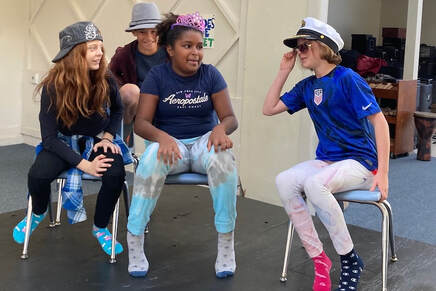
The study of theater engages students in an exploration of the world from multiple perspectives, while developing artistic skills and cultivating their capacities for collaboration, cooperation, reasoning & critical-thinking, creative problem-solving, and effective communication. Other benefits associated with the performing arts are gains in math, reading, cognitive ability and verbal skill. One of the most obvious benefits of performing arts is the development of skills in self-presentation.
A child must learn how to present him or herself in front of an audience, be it big or small. They develop the ability to converse with adults in a mature manner. Participation in the arts allows them to grow their self-esteem and self-confidence, developing poise and learning to overcome anxieties. It allows room for motivation & concentration to develop as children learn self-reliance to reach goals.
From Ms Lissa: “As a drama teacher, I teach from a perspective of truth & feeling and strive to help each student find their truth and develop their strengths within that reality. I emphasize voice & speaking development as well as creative expression in movement in my classes, aiming to connect the physical, emotional and verbal expression of each student. The discovery of the true self is a key to being able to play other characters through the development of empathy and compassion for others. I try to develop a sense of community based on trust in a supportive, brave space. I believe that each actor must practice authenticity on stage and in their lives so I highly encourage my students to take risks and make bold choices, which enrich their emotional life and self—expression from deep within their hearts."
A child must learn how to present him or herself in front of an audience, be it big or small. They develop the ability to converse with adults in a mature manner. Participation in the arts allows them to grow their self-esteem and self-confidence, developing poise and learning to overcome anxieties. It allows room for motivation & concentration to develop as children learn self-reliance to reach goals.
From Ms Lissa: “As a drama teacher, I teach from a perspective of truth & feeling and strive to help each student find their truth and develop their strengths within that reality. I emphasize voice & speaking development as well as creative expression in movement in my classes, aiming to connect the physical, emotional and verbal expression of each student. The discovery of the true self is a key to being able to play other characters through the development of empathy and compassion for others. I try to develop a sense of community based on trust in a supportive, brave space. I believe that each actor must practice authenticity on stage and in their lives so I highly encourage my students to take risks and make bold choices, which enrich their emotional life and self—expression from deep within their hearts."
Movement & Spatial Dynamics
|
Movement is taught by a specialty teacher from 1st through 8th grade. Beyond physical fitness, movement in Waldorf education is used as a teaching tool throughout the curriculum to assist students with everything from learning their multiplication tables to understanding complex physics concepts. Activities work on fine and gross motor coordination, teamwork, sportsmanship, balance, and health. Initiative games, capture the flag, ultimate Frisbee and other traditional sports are introduced throughout the grades. Unicycling is introduced in the 3rd grade and other balance activities strengthen the will, while juggling sticks and diabolos work on fine and gross motor coordination.
|
A highlight of the movement program are the curriculum-related, intramural cooperative games held in the upper grades with sister Waldorf schools including the Pentathlon in 5th grade, Medieval Games in 6th grade, Explorers’ Tournament in 7th grade, and Track Meet in 8th grade.
- Focus on balance, agility, strength and coordination
- Games with rules and strategy
- Cooperation is emphasized over competition
- Advance physical games and movement skills
- Crossing the midline activities to build pathways in the brain and develop the ability to cross the midline, improve coordination and overall functional performance
